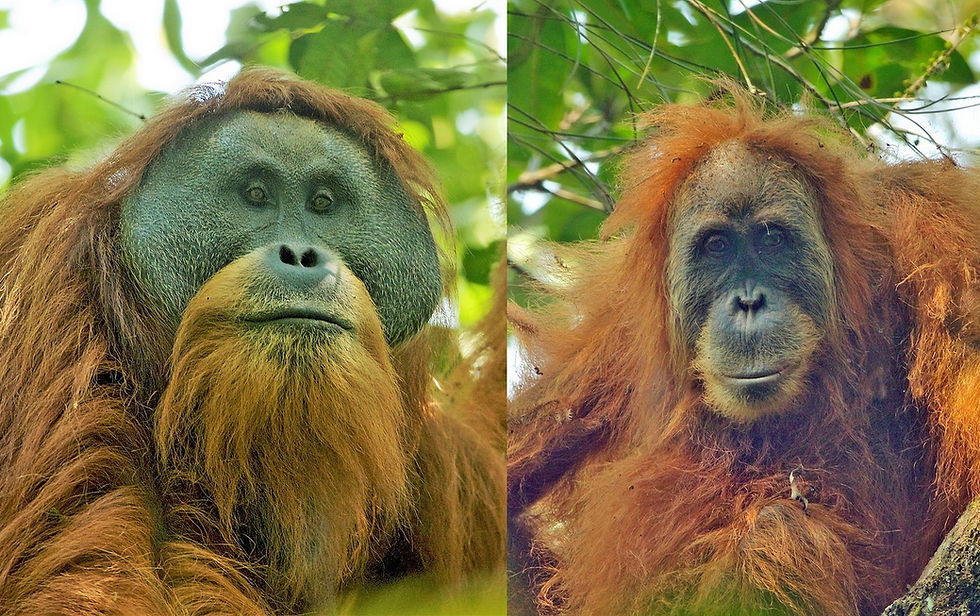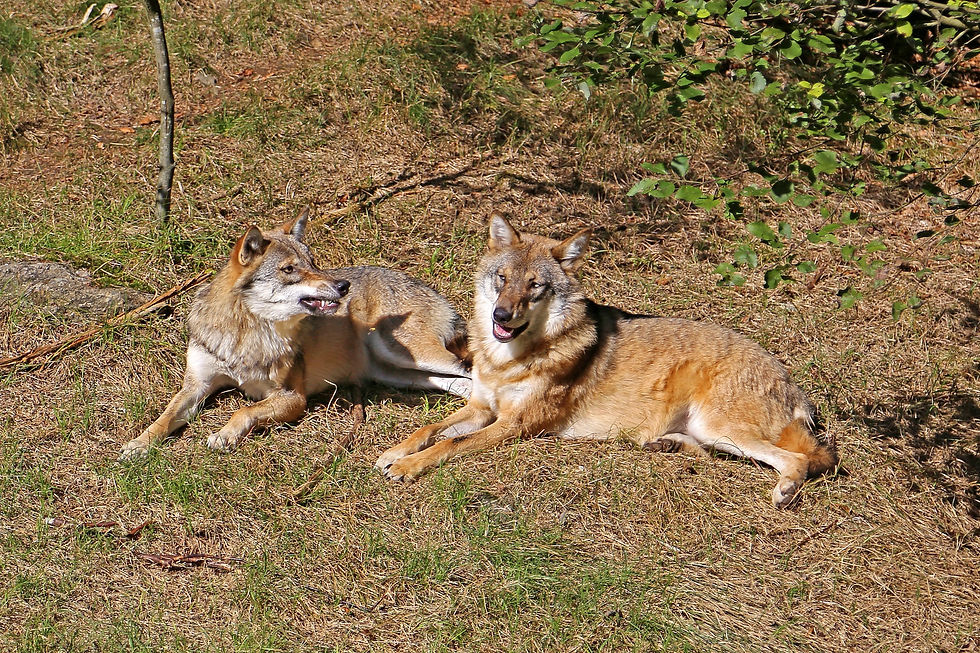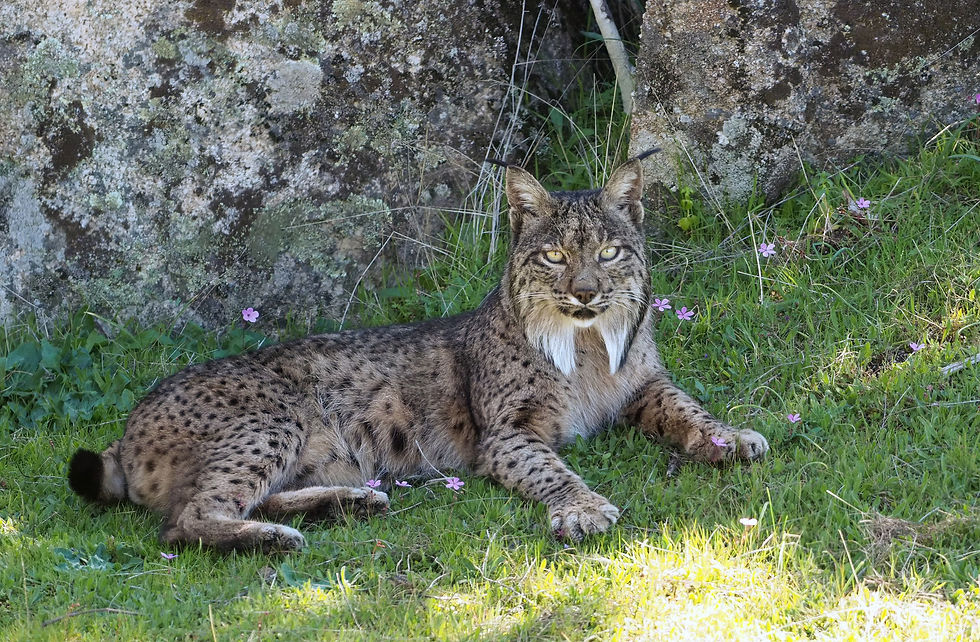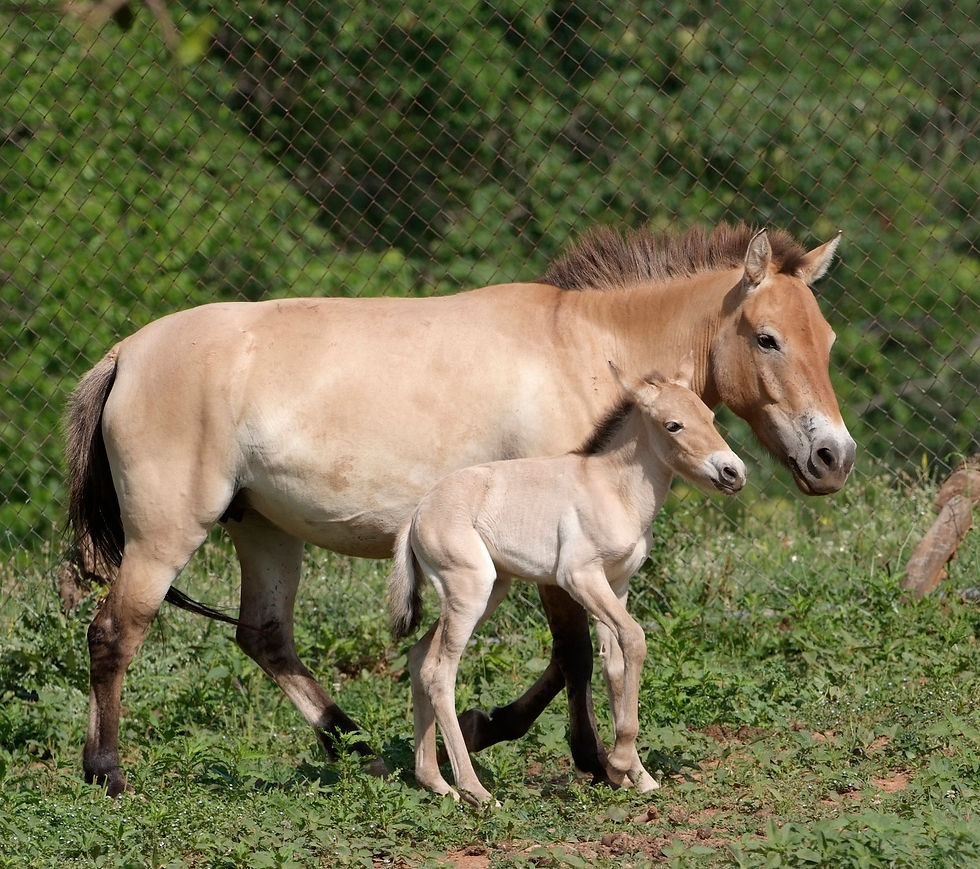Biodiversity loss (II), Homo Sapiens: an invasive species
- jijorquera
- May 26, 2023
- 12 min read
Updated: May 21, 2025
Biodiversity loss (II), Homo Sapiens: una especie invasiva

Each extinct species because of human action, including those that we will never know about, is associated with a cost impossible to calculate. I refer both to the moral damage and the economic cost. Scientists discover around 20,000 new species every year (1), but they still expect to discover about 85% of the world’s animal species (2). As happened in the past century with the distinction between chimpanzees and bonobos, and more recently with orangutans, zoologists are reclassifying other groups of species into different ones. Some of them are at a maximum risk of extinction, such as the African forest elephant or the Sumatran Tapanuli orangutans, with less than eight hundred individuals each. The Borneo orangutan had a population close to 300,000 individuals in 1973 that declined to about 100,000 in 2016 (3), and with an expected additional decay to only 47,000 by 2025 (4). Meanwhile, the current rate of extinction is one hundred to one thousand times higher than that existing before the spread of humanity throughout planet (1,5).
One of the factors contributing to extinction is the sudden appearance of animal or vegetal invasive species. When the species of a certain ecosystem encounter a new one that has not evolved alongside them, they lack competitive or defensive mechanisms against it and can suffer a very rapid extinction. Homo sapiens may be the best example of an invasive species outside the areas where it originally appeared and evolved. When our ancestors left Africa, the new species they met while expanding over the planet suffered the consequences. Many species succumbed in a few generations. They ran out of time to evolve and protect themselves from humans, who possessed an unmatched level of intelligence that they applied to achieve their survival and welfare at the expense of other species (6,7). It is astonishing that our species was also once at the brink of extinction, about 70.000 years ago, when maybe less than 20,000 fertile adults were alive at the same time (4).
A very recent example of an extinct species is the Thylacine (Thylacinus cynocephalus), a carnivorous marsupial animal also known as Tasmanian wolf or Tasmanian tiger. It was an example of evolutionary convergence. Evolutionary convergence occurs when unrelated species develop similar physical forms because they perform comparable ecological roles, in this instance the role of predator. In the figures below one can see the physical similarities of the Thylacine with the wolf (Canis lupus), despite the differences between marsupials and placental mammals.


Scientists estimate that the average mammal species survives for several million years. However, the Thylacine became extinct in 1936, merely 136 years after the first British settlers arrived in its native habitat of Tasmania. However, the Thylacine outlived more than the Aboriginal people of Tasmania, who only survived fifty years the first settlers. Australia holds the all-time record for the rate of mammal extinctions, with thirty-four species vanished since the beginning of the European’s presence in 1788 (8,9).
Another sad example—all cases of extinction are sad by definition—is the mammoth. The last surviving species disappeared definitively 4,000 years ago, shortly after the first arrival of Homo sapiens to its last stronghold, Wrangel Island (6). In 1928, there were around 125,000 blue whales (Balaenoptera musculus) in the world. However, at that time, about fishermen killed 50.000 individuals of blue and other species of whales every year. During the twentieth century, our species killed close to three million whales (10). By 2018 there were only 3,000 blue whales remaining, placing this species among the critically threatened species of the Red List from the International Union for the Conservation of Nature (IUCN, ref. 11).

By the end of the last century, the fishing industry had removed 90% of the large fish from the oceans. The number of fish captured reached a peak around 1990, with eighty-four million tons. Since then, our fishing industry has not been able to increase captures, which indicates an exhaustion of the capacity of the ocean to restore fish stocks. Still today our fishermen catch over eighty million tons of seafood from the oceans each year, leading to a reduction of 30% of fish stocks to critical levels. Aquaculture—fish farming—is now providing about eighty-two million tons of additional seafood to our tables (4).
In 2010, 196 countries belonging to the Convention on Biological Diversity (CBD) set twenty goals for the conservation of flora and fauna, known as the Aichi Biodiversity Targets, to protect and conserve the biodiversity that supports global food security, health, and clean water. However, the 2020 monitoring report indicates that the world did not meet those targets (12). This report broadly coincides with the Living Planet Report 2020 from the World Wildlife Fund for Nature (WWF, ref. 13). WWF’s document states that between 1970 and 2016 the planet saw a 68% average decline of the populations of 4,392 global species of birds, amphibians, fish, and reptiles, from close to 21,000 populations studied. This tragedy is due to the destruction of ecosystems by deforestation, urbanization, intensive agriculture, overexploitation and trafficking of species, pollution, climate change, and the invasion of nonnative species. Forty percent of plants are also at risk of disappearing (14-16). The report of the Intergovernmental Science-Policy Platform on Biodiversity and Ecosystem Services (IPBES) is no less pessimistic (17).
On the other hand, conservation efforts are not useless, since they saved at least forty-three species from extinction, including the Iberian lynx, the California condor, and the pygmy hog (18).

Scientists are applying innovative technologies, such as cloning animals that are at risk of extinction. Przewalski’s horses, that once ranged throughout Europe and Asia, are the only truly wild horses left in the world.

Today we can find Przewalski’s horses only in reintroduction sites in Mongolia, China, and Kazakhstan, and in zoos. However, reintroduced Przewalski’s horses have limited genetic diversity, as all existing individuals originate from just twelve ancestral horses. Thanks to cloning, more genetic variability can now be reintroduced in the wild. Cloning technology is under investigation for extinct species such as the woolly mammoth and the Sumatran rhinoceros, although the challenge is extremely far from being as easy as sometimes depicted (19).
Although saving some threatened species is a remarkable success, it is difficult to avoid the feeling that they are just drops of water in the ocean of disappeared and doomed species. This feeling is especially true if we consider species that are not large mammals, have little or no visibility for us, and therefore we ignore or consider them more distant from us. As an example, linked to the disappearance of vegetation, insects, small but still generally visible to us, have dropped by 25% in the last 30 years. Countries with higher use of pesticides have lost up to 75% of them. In the case of pollinators, the decrease of their populations is a risk to our agriculture (4).
You may also be interested in the series of posts on the climate emergency.
More about biodiversity loss in future posts. You can also visit previous posts of this series:
Versión en español
Cada especie extinguida debido a la acción humana, incluidas aquellas que nunca conoceremos, está asociada a un coste imposible de calcular. Me refiero tanto al daño moral como al coste económico. Los científicos descubren alrededor de 20.000 nuevas especies cada año (1) pero, probablemente, el 85% de las especies animales del mundo aún no se han descubierto (2). Al igual que sucedió en el siglo pasado con la distinción entre chimpancés y bonobos, y más recientemente con los orangutanes, otros grupos están siendo reclasificados en diferentes especies. Algunos de ellos están en riesgo máximo de extinción, como el elefante de bosque africano, los orangutanes Tapanuli de Sumatra, con menos de 800 individuos, o el orangután de Borneo con una población que disminuyó de cerca de 300,000 individuos en 1973 a aproximadamente 100,000 en 2016 (3), con una disminución adicional esperada hasta sólo 47,000 para 2025 (4). Mientras tanto, la tasa actual de extinción es del orden de cien a mil veces mayor que la existente antes de la propagación de la humanidad por todo el planeta (1,5).
Uno de los factores que contribuyen a la extinción es la aparición repentina de especies invasoras animales o vegetales. Cuando las especies de un determinado ecosistema se encuentran con una nueva que no ha evolucionado junto a ellas, carecen de mecanismos competitivos o defensivos contra ella y pueden sufrir una extinción muy rápida. El Homo sapiens es quizás el mejor ejemplo de una especie invasora fuera de las áreas de África donde apareció y evolucionó originalmente. Cuando nuestros antepasados abandonaron África, las nuevas especies que encontraron mientras se expandían por el planeta sufrieron las consecuencias. Muchas especies sucumbieron en unas pocas generaciones. Se quedaron sin tiempo para evolucionar y protegerse de los humanos, que poseían un nivel inigualable de inteligencia que aplicaron para lograr su supervivencia y bienestar a expensas de otras especies (6,7). Es sorprendente que nuestra especie también estuvo una vez al borde de la extinción, hace unos 70.000 años, cuando posiblemente menos de 20.000 adultos fértiles estaban vivos al mismo tiempo (4).
Un ejemplo muy reciente de especie extinguida es el tilacino (Thylacinus cynocephalus), un animal marsupial carnívoro también conocido como lobo de Tasmania o tigre de Tasmania. Fue un ejemplo de convergencia evolutiva. La convergencia evolutiva ocurre cuando especies no relacionadas desarrollan formas físicas similares porque realizan funciones ecológicas comparables, en este caso el papel de depredador. En las figuras se pueden ver las similitudes físicas del tilacino con el lobo (Canis lupus), a pesar de las diferencias entre marsupiales y mamíferos placentarios.
Se estima que una especie de mamífero sobrevive unos pocos millones de años, pero el tilacino se extinguió en 1936, solo 136 años después de la llegada de los primeros colonos británicos a su tierra natal, Tasmania. Sin embargo, el tilacino sobrevivió a los nuevos colonos 100 años más que los aborígenes humanos de Tasmania, que también se extinguieron en 1850. Australia tiene el récord histórico de extinciones de mamíferos, con 34 especies desaparecidas desde el comienzo de la presencia europea en 1788 (8,9).
Otro triste ejemplo —todos los casos de extinción son tristes por definición— es el mamut. La última especie superviviente desapareció definitivamente hace 4.000 años, poco después de la primera llegada de Homo sapiens a su último reducto, la isla de Wrangel (6). En 1928 había alrededor de 125.000 ballenas azules (Balaenoptera musculus) en el mundo. Sin embargo, en torno a esas fechas, alrededor de 50.000 individuos de ballena azul y otras especies de ballenas eran capturadas cada año. Durante el siglo XX, nuestra especie mató cerca de 3 millones de ballenas (10). En 2018 sólo quedaban 3.000 ballenas azules, colocando a esta especie entre las especies críticamente amenazadas de la Lista Roja de la Unión Internacional para la Conservación de la Naturaleza (UICN, ref. 11).
Nuestros pescadores capturan más de 80 millones de toneladas de pescado de los océanos cada año, lo que ha llevado a una reducción del 30% de las poblaciones de peces hasta niveles críticos. A finales del siglo pasado el 90% de los peces grandes habían sido eliminados de los océanos. La cantidad de pescado capturado alcanzó un pico alrededor de 1990, con 84 millones de toneladas. Desde entonces, nuestra industria pesquera no ha podido aumentar las capturas, lo que indica un posible agotamiento de la capacidad del océano para restaurar las poblaciones de peces. La acuicultura (piscicultura) ahora está proporcionando alrededor de 82 millones de toneladas de pescado y marisco a nuestras mesas (4).
En 2010, 196 países pertenecientes al Convenio sobre la Diversidad Biológica (CDB) establecieron veinte objetivos para la conservación de la flora y la fauna, conocidos como las Metas de Aichi para la Diversidad Biológica. Estos objetivos se establecieron en un esfuerzo por proteger y conservar la biodiversidad que respalda la seguridad alimentaria mundial, la salud y el agua limpia. Sin embargo, el informe de seguimiento de 2020 indica que no se han alcanzado los objetivos (12). Este informe coincide ampliamente con el Informe Planeta Vivo 2020 del Fondo Mundial para la Naturaleza (WWF, ref. 13). El documento de WWF afirma que entre 1970 y 2016 el planeta experimentó una disminución promedio del 68% de las poblaciones de 4,392 especies globales de aves, anfibios, peces y reptiles de las aproximadamente 21,000 poblaciones estudiadas. Esta tragedia se debe a la destrucción de los ecosistemas por la deforestación, la urbanización, la agricultura intensiva, la sobreexplotación y el tráfico de especies, la contaminación, el cambio climático y la invasión de especies no nativas. El cuarenta por ciento de las plantas también están en riesgo de desaparecer (14-16). El informe de la Plataforma Intergubernamental Científico-Normativa sobre Diversidad Biológica y Servicios de los Ecosistemas (IPBES) no es menos pesimista (17).
Por otro lado, los esfuerzos de conservación no son inútiles. Al menos 43 especies se han salvado de la extinción, incluido el lince ibérico, el cóndor de California y el cerdo pigmeo (18).
Los científicos están aplicando nuevas tecnologías, como la clonación de animales que están en riesgo de extinción. Los caballos de Przewalski, que una vez se extendieron por toda Europa y Asia, son los únicos caballos verdaderamente salvajes que quedan en el mundo. Casi extinguidos, hoy en día los caballos de Przewalski sólo se pueden encontrar tras su reintroducción en Mongolia, China y Kazajstán, así como en zoológicos. Sin embargo, los caballos de Przewalski reintroducidos tienen una variabilidad genética limitada, ya que todos ellos descienden de sólo doce individuos. Gracias a la clonación, ahora se puede reintroducir más variabilidad genética en la naturaleza. La tecnología de clonación está bajo investigación para especies extinguidas como el mamut lanudo y el rinoceronte de Sumatra, aunque el desafío está muy lejos de ser tan fácil como a veces se indica (19).
Aunque salvar algunas especies amenazadas es un gran éxito, es difícil evitar la sensación de que son sólo gotas de agua en el océano de especies desaparecidas y que van a desaparecer inevitablemente. Este sentimiento es especialmente cierto si tenemos en cuenta especies que no son grandes mamíferos, tienen poca o ninguna visibilidad para nosotros, y por lo tanto ignoramos o consideramos más distantes de nosotros. Como ejemplo vinculado a la desaparición de la vegetación, los insectos, pequeños, pero aun generalmente visibles para nosotros, han disminuido en número un 25% en los últimos 30 años. Los países con mayor uso de plaguicidas han perdido hasta el 75% de ellos. En el caso de los polinizadores, la disminución de sus poblaciones es un riesgo para nuestra agricultura (4).
Para ver otras publicaciones de esta web, use este enlace. Quizá pueda estar interesado en la serie de publicaciones sobre la emergencia climática.
Más sobre la pérdida de biodiversidad en futuras publicaciones. También puede visitar publicaciones anteriores de esta serie:
Images / Imágenes
Orangutan (Pongo_tapanuliensis, male and female) / Orangután (Pongo_tapanuliensis, macho y hembra). Author / Autor: Tim Laman. https://commons.wikimedia.org/wiki/File:Pongo_tapanuliensis_male_female.jpg. CC BY-SA 4.0 <https://creativecommons.org/licenses/by-sa/4.0>, via Wikimedia Commons
A female Thylacine and her calf, in 1903 / Una hembra de tilacino y su cría, en 1903. Author / Autor: Baker; E.J. Keller. “Tasmanian ‘Zebra Wolf’”. Circa 1903. https://commons.wikimedia.org/wiki/File:Thylacinus.jpg. Public domain, via Wikimedia Commons. Accessed on July 16, 2021.
Wolves / Lobos. Author / Autor: W. Bulach. https://commons.wikimedia.org/wiki/File:00_8946_W%C3%B6lfe_im_Freigehege.jpg. CC BY-SA 4.0 <https://creativecommons.org/licenses/by-sa/4.0>, via Wikimedia Commons. Accessed on July 16, 2021.
Blue whale painting / Dibujo de Ballena azul. Postverk Føroya - Philatelic Office. Faroe_stamp_402_blue_whale_(Balaenoptera_musculus) crop.jpg. https://commons.wikimedia.org/wiki/File:Faroe_stamp_402_blue_whale_(Balaenoptera_musculus)_crop.jpg., Public domain, via Wikimedia Commons
Iberian Lynx / Lince Ibérico. Author / Autor: Frank Vassen from Brussels, Belgium. Male_Iberian_Lynx_(Lynx_pardinus),_La_Lancha,_Parque_natural_de_la_Sierra_de_Andújar,_España_(32609200053).jpg https://commons.wikimedia.org/wiki/File:Male_Iberian_Lynx_(Lynx_pardinus),_La_Lancha,_Parque_natural_de_la_Sierra_de_And%C3%BAjar,_Espa%C3%B1a_(32609200053).jpg. CC BY 2.0 <https://creativecommons.org/licenses/by/2.0>, via Wikimedia Commons.
Przewalski’s horse / Caballo de Przewalski. Author / Autor: Jessie Cohen, Smithsonian's National Zoo. https://www.si.edu/object/przewalskis-wild-horse:nzp_NZP-20080703-1102JC. Smithsonian's National Zoo & Conservation Biology Institute, Front Royal, USA.
References / Referencias
1. Edward O. Wilson. The Meaning of Human Existence. Liveright Publishing Corporation, New York, 2014.
2. Moura, M.R., Jetz, W. Shortfalls and opportunities in terrestrial vertebrate species discovery. Nat Ecol Evol 5, 631–639 (2021). https://doi.org/10.1038/s41559-021-01411-5.
3. International Union for Conservation of Nature, 2021. African Forest Elephant. https://www.iucnredlist.org/species/181007989/181019888. Accessed on June 29, 2021; Roser Gari. Los oragutanes tapanuli. Cronología de una muerte anunciada. ElDiario.es, https://www.eldiario.es/caballodenietzsche/oragutanes-tapanuli-cronologia-muerte-anunciada_132_8495968.html, 2021, Accessed on November 18, 2021.
4. David Attenborough. A Life on Our Planet. My Witness Statement and a Vision for the Future. Ebury, Penguin Random House UK, London, 2020.
5. IPBES. (2019). Global assessment report on biodiversity and ecosystem services of the Intergovernmental Science-Policy Platform on Biodiversity and Ecosystem Services (Version 1). Zenodo. https://doi.org/10.5281/zenodo.6417333.
6. Yuval N. Harari. Sapiens. A Brief History of Humankind. Random House UK. London, 2015.
7. A.M. Jukar, S.K. Lyons, P.J. Wagner, M.D. Uhen. Late Quaternary extinctions in the Indian Subcontinent. Palaeogeography, Palaeoclimatology, Palaeoecology. Volume 562, 2021,110137, ISSN 0031-0182, https://doi.org/10.1016/j.palaeo.2020.110137.
8. Edward O. Wilson. On Human Nature. Harvard University Press, Cambridge, MA, 1978/2004.
9. Adam Langenberg. Lost remains of last-known Tasmanian tiger found at museum, solving ‘zoological mystery’. ABC News. https://www.abc.net.au/news/2022-12-05/last-tasmanian-tiger-remains-found-in-museum-cupboard/101733008. Accessed Dec 9, 2022. Emily Roycroft et al. Museum genomics reveals the rapid decline and extinction of Australian rodents since European settlement. PNAS July 6, 2021 118 (27) e2021390118; https://doi.org/10.1073/pnas.2021390118.
10. Daniel Cressey. World’s whaling slaughter tallied. Nature 519, 140–141 (2015). https://doi.org/10.1038/519140a.
11. International Union for Conservation of Nature, 2021. https://www.iucnredlist.org/. Accessed on June 29, 2021.
12. Convention on Biological Diversity, 2020. https://www.cbd.int/gbo5. Accessed on June 29, 2021.
13. World Wildlife Fund, 2020. https://f.hubspotusercontent20.net/hubfs/4783129/LPR/PDFs/ENGLISH-SUMMARY.pdf. Accessed on March 8, 2022.
14. Humphreys, A.M., Govaerts, R., Ficinski, S.Z. et al. Global dataset shows geography and life form predict modern plant extinction and rediscovery. Nat Ecol Evol 3, 1043–1047 (2019). https://doi.org/10.1038/s41559-019-0906-2.
15. Antonelli A. et al. (2020). State of the World’s Plants and Fungi 2020. Royal Botanic Gardens, Kew. DOI: https://doi.org/10.34885/172. Accessed on July 16, 2021.
16. Jeff Tollefson. Humans are driving one million species to extinction. Nature 569, 171 (2019). https://doi.org/10.1038/d41586-019-01448-4.
17. Intergovernmental Science-Policy Platform for Biodiversity and Ecosystem Services (IPBES). https://www.ipbes.net/news/media-release-biodiversity-nature%E2%80%99s-contributions-continue-%C2%A0dangerous-decline-scientists-warn. Accessed on July 16, 2021.
18. Friederike C. Bolam et al. How many bird and mammal extinctions has recent conservation action prevented? Conservation Letters. 2021; 14: e12762. https://doi.org/10.1111/conl.12762.
19. Madeleine Carlisle. First Clone of Endangered Przewalski’s Horse Born in Conservation Effort to Save the Species. https://time.com/5886467/clone-endangered-przewalskis-horse-zoo/. Accessed on July 16, 2021.






Comments